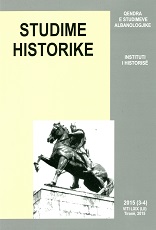Gjuha, Shkolla e Kombësia në Shqipërinë e Poshtme në Shek. XIV-XVIII
Language, Education and Nationality in Lower Albania between the 14th and 18th Centuries
Author(s): Pëllumb XhufiSubject(s): Christian Theology and Religion, Cultural history, Diplomatic history, Ethnohistory, 13th to 14th Centuries, 15th Century, 16th Century, 17th Century, 18th Century
Published by: Qendra e Studimeve Albanologjike
Keywords: Albania; Language; Education; nationality;
Summary/Abstract: In this article we aim to explain the historical and cultural conditions in which were developed in Lower Albania, the language, education and even the Albanian national idea. These developments in this area encountered supplementary difficulties even compared with other Albanian territories. The presence of a strong Catholic community in the north attracted the attention and protection of the Papacy and the Catholic powers of Europe, which was reflected in the establishment since the Middle Ages, of a cultural inspiration of national character. Rather, in the south of the country simply dominated the concept of the Sublime Porte, that was also adopted from the Ecumenical Patriarchate of Constantinople itself and even from the European political and cultural circles, that considered that the Muslims were Turks, and the Orthodox were Greeks. Such a bias conditioned the policies and approaches of the Sublime Porte and of the European circuits, creating difficult conditions for the Albanian national idea. Consequently, in southern Albania, the Greek language continued in the post-Byzantine period to be the language used in cultural and diplomatic circles. It was used for communicational purposes not only by the Orthodox clerical circles, but also by secular circles. Sometimes even some Ottoman dignitaries used to communicate in Greek in their correspondence with Western chancelleries. In many cases, the use of the Greek language in these correspondences was determined by the fact that the profession of the writer and of the emissaries was an attribute of the clergy, for whom the Greek language was the language of faith but also a language of culture. The second reason lay in the broad privileges given to the Patriarchate of Constantinople after 1453 from the Ottoman sultans in the areas of civil administration and education. In this way, with the support of the Sultan, the Constantinopolitan Patriarchy and its network of clerics intended to guide the Orthodox populations on the road of Hellenization. Such a trend was reinforced when to the Patriarchy was granted the right to open Greek schools among Albanian Orthodox populations, and when after 1821, to the Hellenization action of the Constantinopolitan Patriarchy and of the Greek clergy in Albania, was added the organized action of the Greek state. Eighteenth and nineteenth century chronicles are full of examples of this combined action of the church and the Greek state to eradicate the language, culture and national idea among the southern Orthodox Albanians. Despite these unfavorable circumstances, even in the Lower Albania there were efforts for the development of the Albanian language and culture. A famous example is that of schools and publications in Albanian promoted by the Basilian missionaries in the region of Himara, during the 17th and 18th centuries. Also, the efforts to draft Albanian original alphabets, different from the Greek, Slavic and Latin alphabets, testify the development of a national consciousness by the most progressive layers of the Albanian society. It is not without significance, too, that during the 16th-18th centuries, individuals or entire Albanian communities of different cultural and religious backgrounds, considered as an important reference of their identity, well-known figures in the history of Albania, starting from Pyrrhus of Epirus, Alexander the Great of Macedonia and especially Georg Kastriot Scanderbeg
Journal: Studime Historike
- Issue Year: 2015
- Issue No: 03-04
- Page Range: 7-24
- Page Count: 18
- Language: Albanian
- Content File-PDF

